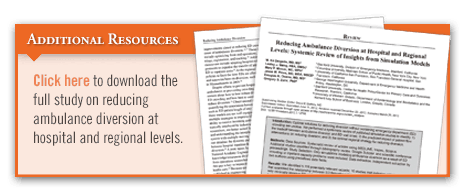Recent data indicate that about 45% of EDs in the United States report being “on diversion” at some point within a given year to alleviate crowding. “Although ambulance diversion has been used for quite some time, several studies link these diversions to negative consequences,” explains M. Kit Delgado, MD, MS. “These include prolonged transport times, delays in care, higher mortality, and lower hospital revenue.”
Efforts have been made to reduce ambulance diversion in the past. These strategies include implementing ED patient-flow improvements. “Optimizing front end operations, such as patient triage, registration, and tracking, is also important,” says Dr. Delgado. “Other improvement efforts include adopting hospital-wide full capacity protocols to expedite the transfer of admitted patients from EDs to inpatient units.”
New Insights on Diversion & Crowding
Questions remain about the strategies that can best reduce diversion without increasing ED crowding and how best to coordinate these efforts. In the Western Journal of Emergency Medicine, Dr. Delgado and colleagues had a study published that systematically reviewed simulation model investigations. “Our overall goal was to gain insights on how to optimally reduce ambulance diversion,” Dr. Delgado says.
The analysis identified 10 studies that used simulations modeling ambulance diversion as a result of ED crowding or inpatient capacity problems. Results showed that ambulance diversion only minimally improved ED waiting room times. Strategies that were found to reduce diversion considerably include:
1. Adding holding units for inpatient boarders.
2. Adding ED-based fast tracks.
3. Improving lab turnaround times.
4. Smoothing out elective surgery caseloads.
“The desired effect of reducing ED waiting room times by diverting ambulances is likely to be very small,” says Dr. Delgado. “We also found that if diversion is used, the decision to divert should be made based on the number of patients in the waiting room or number of ED boarders instead of just a lack of inpatient beds. Smoothing elective surgical admission caseloads is a dynamic bed management strategy that would likely reduce ambulance diversion and could increase hospital revenue.” Implementing regional cooperative agreements among hospitals is another promising avenue for reducing diversion.
Looking Forward to Reduce Diversions
The study by Dr. Delgado and colleagues confirms that cooperative strategies among hospitals may be helpful in preventing “defensive” or “preemptive” diversions. Banning ambulance diversion is one way to prevent “preemptive” diversions, but some studies indicate that a system that enabled distributing patients to the least crowded EDs would be more efficient. “Banning diversion may motivate hospitals to be more committed to using strategies that maximize the number of inpatient beds that are available,” Dr. Delgado says. “Data are also needed to project the effects of using ambulance diversion bans on ED throughput times, outcomes, and hospital revenues.”




 TimH
TimH